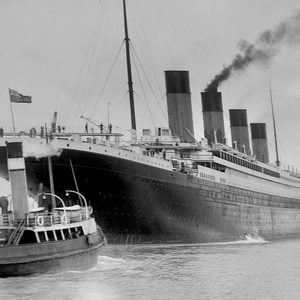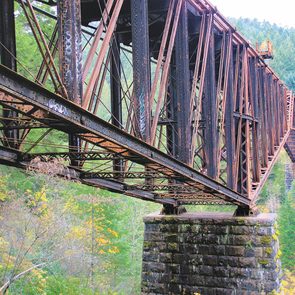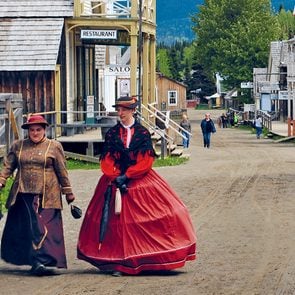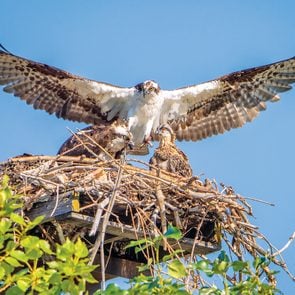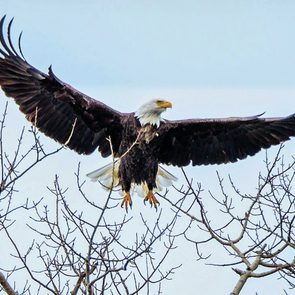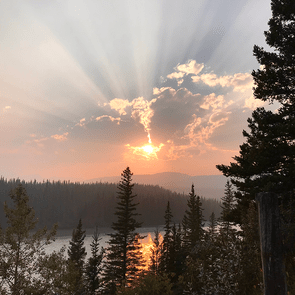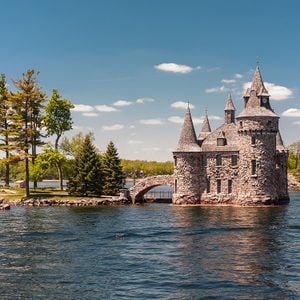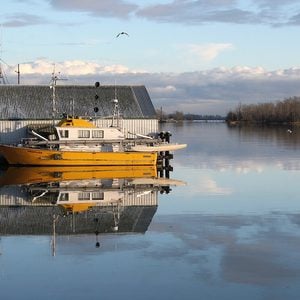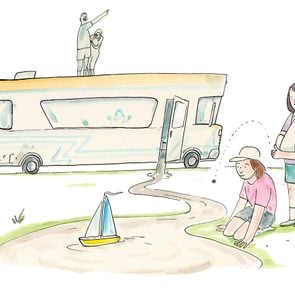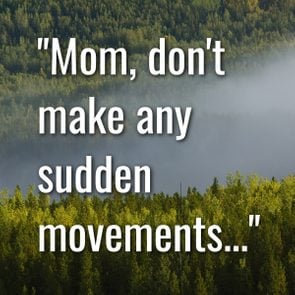
July 29, 1916 began as a hot, dry, hazy day in the northern Ontario town of Matheson. Despite the smoke in the air, residents went about their usual Saturday morning chores—the smell of burning wasn’t unusual in the tiny settler village, built along the new Temiskaming railway line. Encouraged by the government to set up homesteads, European immigrants cleared the land by burning the dense brush. With no rain for weeks, several small fires on the outskirts were already beginning to grow, but the townspeople had no reason to believe anything was out of hand.

Around midday, William Dowson noticed something in the sky as he took his lunch break from a job mixing concrete. “One of the workmen called our attention to a black cloud over the treetops,” wrote the 21-year-old bricklayer in his diary. “We all decided it was a thunder cloud and paid no attention, until a wave of heat and a thick pall of smoke struck our shed with such force that it almost collapsed.”
The exact origins of the fire are still a mystery—most say high winds whipped a number of smaller fires into one huge firestorm. Others blamed the railway companies, which often used dynamite to blast through rock. Whatever the case, a gigantic inferno with a front over 60 kilometres long raced eastward at 40 to 60 kilometres per hour, totally unstoppable.
Dowson saw panicked townspeople filling buckets and basins with water from the Black River in a futile effort to douse the oncoming flames. As the fire rolled over one town after the next, some managed to survive by wading chest deep into the river, breathing through wet clothing to filter the searing hot smoke. Some climbed on board a boxcar train that punched straight through the wall of fire, while people stuffed wet cloths between the slats. Dowson took cover huddling under a makeshift shelter made from boxes and a wet tarpaulin.
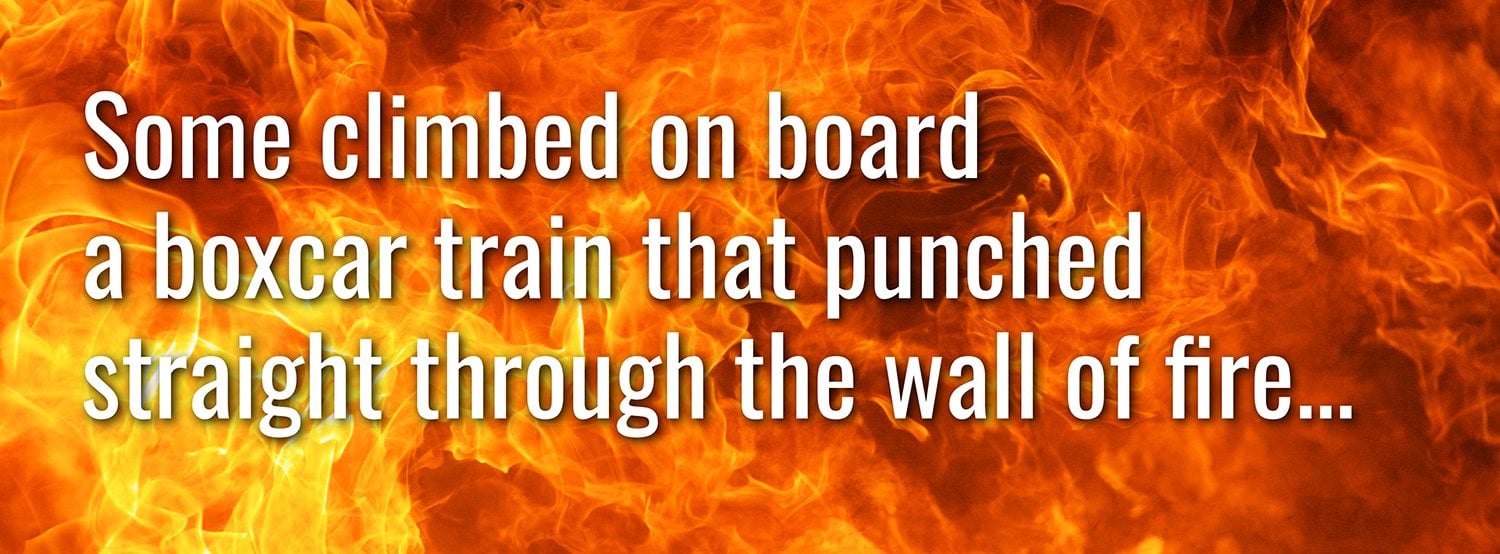
By the time the blaze died down several days later, it had incinerated more than 500,000 acres (an area the size of Toronto, Montreal and Calgary combined). Entire communities were razed: Matheson, Iroquois Falls, Nushka, Porquis Junction, Kelso, and Ramore, with extensive damage to Homer, Monteith and Cochrane. Officials accounted for 223 dead, but with many bodies burned beyond recognition, it’s thought the toll may have been closer to 500—prospectors, trappers and drifters often passed through frontier towns in search of their next adventure.

Dowson walked back into Matheson to find a scorched hellscape where the town once stood, corpses littering the ground. “Swept away,” he wrote. “All of it.” The neighbouring town of Nushka was also wiped off the map, with only eight survivors. It was later rebuilt as Val Gagné, after Catholic priest Wilfrid Gagné. He was credited with trying to save 63 parishioners by leading them to a narrow trench by the railway tracks. Tragically, as the fire roared over the town, they all suffocated from the smoke and carbon monoxide.

The Matheson fire shared front-page news with World War I for days, and outrage spread over the lack of fire protection. At the time, Ontario was the only province lacking any regulation of the practice of burning brush to clear land. What’s more, it wasn’t the first devastating forest fire in the region—five years earlier, the Great Porcupine Fire of 1911 swept through 200,000 acres and killed 70.

All of that changed a year later with the introduction of the Forest Fires Prevention Act of 1917, a landmark piece of legislation that created Ontario’s modern fire control system. Along with requiring permits for all land-clearing fires, the government began investing in the prevention, detection and suppression of forest fires, creating a provincial firefighting corps and hiring 1,000 rangers to patrol the lands. A network of hundreds of fire lookout towers were built across the province, where watchmen surveyed the horizons until the 1960s, when aerial fire detection planes took over.
Today, all that remains of the 1916 tragedy are the artifacts housed in the Thelma Miles Historical Museum in Matheson, and a memorial plaque in the town centre. While the devastation caused by the fires in Matheson and other Northern Ontario communities brought many improvements to the way we understand and respond to forest fires, the horror of that July day remains seared on our collective conscience.
Next, find out why 1816 is known as the year Canada didn’t have a summer.
In the summer of 1950, my father met us at Malton Airport (now Pearson International Airport) in Toronto. My first imrpession of Canada was the large car he was driving. In Scotland, I hardly knew anyone who owned a car and certainly nothing as big as this 1956 Chevrolet. Back home, we only travelled by bus and train. I was overwhelmed by these mammoth machines traversing all around us! Everything in this new country looked so much larger.
“Is this your car, Dad?” I asked.
“No, it’s your Uncle Charlie’s. He’s thinking of getting a new one. I might try and buy this one, but don’t say anything.”

Uncle Charlie and Aunt Elsie had no children and, although not blood relations, we were very close. Everything they owned was immaculate. Over the coming years, we would visit often. I would sit on the carpet terrified of breaking something. I would stare at this huge black porcelain panther. I had nightmares whereby I somehow stumbled and knocked it off the coffee table. I knew this would be an indiscretion I would have to live with for the rest of my life. It would rank up there with the time I drew a moustache on my sister’s favourite doll!
We returned the car and I was introduced to Uncle Charlie, however my attention was solely on the automobile. I could feel Uncle Charlie’s eyes on me as I walked around it, kicking the tires and feeling the chrome.
Uncle Charlie asked, “Do you like the car?”
“Yes,” I answered, “my father is going to buy it.”
I could tell by my father’s grimace and the hand over his face that I had said too much. Nevertheless, my father did buy the car and it slowly degenerated over time. It would sit during the day in the Stelco parking lot and get covered with a fine grit from the steel plant. On the weekends, my father would do masonry work around Hamilton. The inside of the trunk was always covered with cement and bricks.
On family outings, my parents would smoke with the windows rolled up. The air was permeated with the smell of stale tobacco and chalky masonry cement. The dog and I would lie on the back floor, gasping. They would always question why I got car sick.
When people visited from the old country, we always made a trip to Niagara Falls. In those days you could park right beside the falls.
One afternoon, my father sped up the driveway. He ran into the house and I could hear him yelling angrily to my mother. He then came running out of the house and started spraying the car with a hose. Items were flying out of the trunk and the interior of the car. My friends gathered on the lawn and someone suggested I go in the house and ask my mother what was happening.
“Your father found a citation from the city of Hamilton under the windshield wiper. It says that his car is a disgrace to the city and if he doesn’t clean it, the city will clean it and charge him for it,” she said.
No sooner had he finished cleaning the car than a shiny new Chevrolet pulled up to the house and Uncle Charlie got out.
“Nice job on the car, Eddy,” he said, “I see you got my citation.” As things turned out, it wasn’t the city of Hamilton but one of the secretaries at the Firestone plant where Uncle Charlie worked that had written up the citation.
My father, a jokester himself, took it all in good stride.
Next, read the incredible story of how one man missed out on his dream car as a teenager, then found it parked in his driveway 25 years later.
When I look back on it, 2019 was a big year. It was the year I turned 50, the year we returned to Canada after living in New Zealand for three years, and the year my husband, Tim, and I celebrated our 25th wedding anniversary. Some people celebrate those milestones in a big way, but having recently returned to Vernon, B.C., we had just moved relatives out of a house, and repainted and moved ourselves in—so we found ourselves too tired to plan anything.
We do love exploring new things though, and since the Okanagan Rail Trail opened while we were away, we decided to enjoy the sunshine and go for a ride on electric bikes, which we had also never tried before.

Getting accustomed to e-bikes
I used to wonder if riding an electric bike was cheating, but contrary to many beliefs, you still have to pedal to make the bike move, meaning I got a workout while going further, faster. So, after experiencing one, I now believe that any movement is good movement. I’m sure that attitude has nothing to do with the aches that come with an older body! Also, it was lovely not having to worry about a headwind, plus, if it’s a hot day, you can just ride faster and create your own breeze. We rented our e-bikes for two hours from the Kalavida Surf Shop in Coldstream. I didn’t know how comfortable I would be using all the speeds, but it didn’t take long to adjust to the faster pace and soon we were cruising along, often passing the other parties on the trail. Be warned, there are lots of people on the trail as it is well-used by walkers, joggers and cyclists all year round. This is probably because the trail is relatively flat and offers ever-changing views of Kalamalka Lake around each corner. Kalamalka is one of those surprise lakes that changes colour for a short time most summers, due to leftover limestone deposits from receding glaciers. It’s always fun to watch the transition from dark blue to light green and turquoise. It’s quite spectacular. It hadn’t changed to its brightest colour yet on the day we rode, but it’s a beautiful lake in any month. I especially like the sparkly water diamonds created by the sun.

Wildlife abounds on the Okanagan Rail Trail
Whenever outdoors, we are constantly scanning for wildlife and that day we caught a glimpse of a coyote escaping up the bank. We also had a game of peek-a-boo with a friendly merganser duck. The array of rock colours along this trail is a wonder. The reds, blacks, browns and greens are splashed on the rock walls like beautiful abstract art. When you see those same colours sparkling in lighter shades below the water you’ll be tempted to stop for another photo. Try to capture a scraggly sage bush in your photo for extra texture. Unfortunately, our day turned a bit cloudy; so hope for a sunny day for those contrasting colours to really shine.
What we’ll do differently next time
Our two-hour rental gave us plenty of time to ride to the beautiful little town of Oyama, where we took a break to have a cool drink at Gatzke Orchard before turning around and heading back to Coldstream. We usually like doing loops, but it’s always surprising how different a trail can look when going in the other direction. One thing we didn’t do was bring our swimsuits. We will definitely do that next time, as well as book the bikes for longer so we can ride around Wood Lake, too. A refreshing swim would have been just the thing, but we had a dinner reservation to get to because who wants to cook on their anniversary?
Inspired to tackle the Okanagan Rail Trail? Check out more of Canada’s best bike trails.

Southampton, Ontario is a small and enchanting town. And in its middle, there’s a faery lake. Every Friday evening in the summer months in this enchanting town, a bagpiper pipes down the sun as it sets in the west. The sunsets are often long and lingering, breathtaking and beautiful.
The piper pipes tunes that many who gather at the piping spot recognize: “Loch Lomond” and “Danny Boy” and “Mull of Kintyre” and “Amazing Grace.”
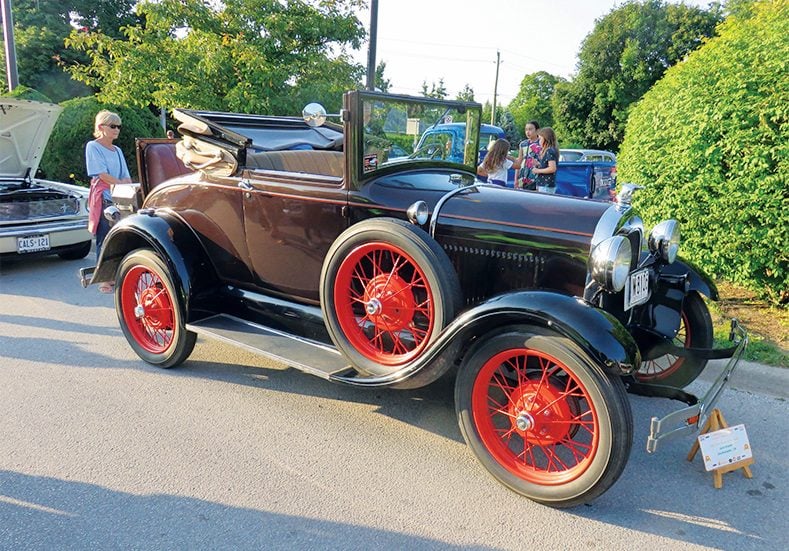
Cruise Nights in Southampton, Ontario
Every Thursday evening in the summer months, antique car nuts bring their automobiles to town, and they park them at the end of the main street and show them off and talk about engines and miles-per-gallon and where they are going this summer and where they went last year.
A hundred cars each week show up, including a ’57 Merc owned by Gary Brown, who started the event 25 years ago.
People stroll about and admire the antique cars and talk with the owners and take photos.
“Since inception, our raffle sales and 50/50 sales from Cruiser Nite have raised almost $300,000, all of which has been donated to the local hospital,” Gary, known locally as Mr. Cruiser, happily explains when asked.
On the short but astonishingly wide main street, there are two small but excellent owner-operated hardware stores for the home and cottage handyman. And an excellent owner-operated bakery whose specialty is the Bruce Potato (which is not a potato at all).
There’s an excellent sports bar and restaurant with an outdoor patio that caters to sports enthusiasts and families, and hosts excellent dinner events. Not to mention the excellent theatre in the Old Town Hall, whose local troupe puts on excellent plays in the summer, and has lately linked up with another excellent local restaurant to offer excellent dinner/theatre evenings.
In short, this enchanting town provides an abundance of excellence!
Once a year, a huge boat race is held in a protected lagoon on Lake Huron near the enchanting town. It’s for kids only and the boats must be made from cardboard and duct tape. The course of the boat race is not long; nevertheless, the young contestants often get turned around and race off helter-skelter in all directions as the spectators, lined up four-deep, yell encouragement amid a lot of laughter.
Fortunately, the pirate Captain Sparrow is close by, and he and his able crew assist in getting out-of-control boats pointed back in the right direction.
These hidden gems of Ontario are yours to discover.

Nearby Attractions
Not far away is Chantry Island, which has on it an old lighthouse. Boats manned by volunteers from the enchanted town take people out for a visit. Chantry Island is a protected cormorant nesting ground, and in the trees around the lighthouse are the nests of cormorants. Hundreds of noisy cormorants!
Nearby is another town where Wiarton Willie lives. Wiarton Willie is the groundhog who pokes his nose out of his burrow on Groundhog Day and decides how much longer winter is going to last. In that town there is found a magnificent statue of Willie.
Not far away near the village of Tara is the Keady Auction Barn, where every week farmers come from great distances to place bids on a great number of four-legged, hoofed animals. The farmers understand the fast-talking auctioneer, and they occasionally nod and raise their hands ever so slightly. People who are not farmers and have just come to watch haven’t a clue what the auctioneer is saying. But the farmers do and a great number of farm animals are auctioned off.

Nature in Abundance
Did I mention that there is a wonderful walking trail around the faery lake in the middle of this enchanting town? And as people stroll around the faery lake, they often come across one sort of living creature or another.
They see foxes. And they see painted turtles and rabbits. And they see cormorants and herons and ospreys and robins and orioles and owls and hummingbirds. Often they see the birds catch a fish from the faery lake.
And they see ducks and geese and monarch butterflies, for the enchanting town is a monarch butterfly sanctuary.
These beautiful butterfly pictures will take your breath away.

And they see wood sculptures of many of the creatures who live around the faery lake. And every Sunday evening in the summer, there is a marvellous musical concert that people can comfortably settle in to and watch, provided they have brought their own camp chairs. Otherwise, they have to sit not-so-comfortably on the hard ground.
And of course as people stroll around the faery lake, they see other people also out for a stroll around the faery lake.
My wife and I visited the enchanting town in the summer to spend a bit of time with our grandchildren, for our daughter and son-in-law have a cottage there.
We were living in the Yukon when she and her brothers were growing up, and she loved the time spent at our rustic log cabin. The lake on which that cabin sat was on the trail of the Klondike Gold Rush, and we had our own beach and a spectacular view of mountains.
Now our daughter and her family have their own magical place, on a faery lake in the heart of the enchanting town of Southampton, Ontario. And the faery lake in the middle of it all is called, aptly enough, Fairy Lake.
Next, check out our gorgeous gallery of Canadian lighthouses.
Canada’s Budget Airlines: What to Expect
With the 2022 launch of Lynx Air, Canada’s skies are getting increasingly crowded with budget airlines. Some of them are betting big on success—Lynx alone has committed to adding up to 46 new Boeing 737s to their fleet over the next several years. But those who choose Lynx, Flair, or Air Canada Rouge may be in for some surprises, even before you board the plane. If you’re thinking about booking a seat for a budget-friendly getaway, here’s what you should keep in mind.
Be Prepared to Pay for Extra Services
Know up front: a budget airline’s stripped-down business model gets you a seat on a plane flying from A to B—and nothing more. That’s how they’re able to turn a profit. Julie Gilcrest, an advisor with The Travel Agent Next Door, a Toronto-based travel agency, says a number of services most people consider core or fundamental—and which usually come free on “legacy carriers” like Air Canada and WestJet—come with extra costs. “Make sure to read the fine print,” she says.
For example, even carry-on bags carry are subject to a surcharge (from $60 plus tax on Lynx, for example) and checked bags can be very expensive (as much as $92). Seat selection (even at check-in), printing a boarding pass, or even dialling the call centre with a question may come with an added cost. Travel writer Debbie Olsen, who has flown Swoop, Lynx and Flair, adds that it’s a good idea to purchase and pay for baggage fees beforehand, online. In the end, how much you’re able to save depends on several factors, such as route, timing and how many people are booked for a given flight.
Book Everything in Advance
It’s more expensive if you wait to do so at the airport. For example, on Lynx, you’d save ten bucks on that carry-on if you’d booked it in advance, online, and they can be as much as $25-30 cheaper on other low-cost carriers (LCCs). Overall, she advises travellers to add everything up before booking to make sure they’re actually saving money, even with the smaller individual costs. Often, the savings can still be significant.

Pack Your Patience (And Snacks)
Frequent LCC flier Jodie Fluit warns passengers to prepare for small, unexpected hassles. For example: on a recent Swoop flight out of Hamilton, she’d checked in online, but she still had to stand in a queue to drop her baggage, a process that’s been streamlined with legacy carriers. And on board, she says, expect the seats to be smaller, with less recline, and to pay for every item, even water. (Sometimes no food or drink is available at all.) It’s an absolutely, unapologetically no-frills experience, from start to finish.
Have a Back-Up Plan
Another, less-obvious consideration: Gabor Lukacs, director of the Toronto-based non-profit organization Air Passenger Rights, warns that if your flight is disrupted—delayed or cancelled—your options for rebooking may be scant. Budget airlines in Canada tend to operate very limited routes and, unlike legacy carriers, do not rebook on other airlines to get you to your destination sooner. If, for example, the low-cost airline you’ve chosen flies from Calgary to Vancouver only three times a week, you may be waiting days—not hours—in the event of a cancellation.
That happened to Heather McEachen, a Vancouver Island-based communications specialist. She saved $600 last summer by flying her family with Swoop from Victoria to Edmonton. Before their return, she got a notification that her flight was delayed. “I had assumed it was just an hour,” but then she double-checked. “Nope. It was a whole day.”

Are Budget Airlines Worth It?
While some unfortunate incidents have captured headlines (including a well-publicized diversion in January 2022 that sent Waterloo-bound passengers on a Flair flight to Toronto, with no shuttles provided to get home), a number of customers say, given the right set of circumstances, they’d fly a LCC again.
Fluit notes she’d fly with budget airlines in Canada again if the savings were significant, and her schedule was flexible. For Olsen, it’s about the routing—she flew from Calgary direct to Charlottetown, a flight not available on other carriers, and would do it again. And even McEachen would consider it. “As a family, the savings work for us,” she says, given a relatively short flight requiring minimal baggage. “You just need to be prepared. And make sure to bring your own snacks.”
Now that you know the ins and outs of budget airlines in Canada, check out this doctor’s health tips for travelling seniors.

Neighbours came for the early morning send-off to wish me and my husband, David Clyne, a good trip. Our boat was on the trailer, and the trailer was attached to the truck. The last of the supplies were loaded and the key was in the truck’s ignition.
Then, the unthinkable happened. All we heard was the loud clicking of an engine that wouldn’t start. Thankfully, a boost was all that was needed to get us on our way.

The Bumpy Start Continues
The country road was rough, and we felt some vibration as we drove along. Dave was a little uneasy about the truck, saying, “I’m not turning off the engine. I just don’t trust it. Oh, by the way, we lost the boat’s trumpet horn along the way.” An hour and a half later, we arrived at the Rideau Ferry Harbour.
The launch went smoothly at first; our boat slip was in a good spot. A relaxing afternoon was planned, to be followed by boating to a nearby restaurant for Dave’s birthday supper. The check of the bilge, however, was an unwelcome sight. We hoped the water in it was rainwater. It was not. There was too much, in fact, several buckets-full had to be emptied. In a disappointed tone, Dave said, “We are going back home.”
Those were not the words I wanted to hear. Dave had spent months restoring, repairing and replacing rotten wood where leaks had been discovered. He was sure he’d fixed them all. For months we had been looking forward to our 12-day cruise on the Rideau Canal, a UNESCO World Heritage Site. We had to haul the boat back out of the water, which takes time. Factors such as currents, wind and many other docked boats can and do slow down the job. It took about an hour. We were hopeful that in a day or two the boat would be fixed and we would be good to go. Dave is good at fixing almost anything.
The marina owner, John, approached us as we were about to leave. He was sympathetic, suggesting something about a “quick, temporary fix” that could get us back in the water. “I don’t like to see you lose your whole holiday.”
Would Dave consider this idea? Leave the boat for an assessment and agree to let boat mechanics do the job? After what seemed like a long few minutes, the boat trailer was unhitched, and we drove away leaving the boat for repairs with a tired and disappointed Dave saying, “Keep an eye out for the horn.”

Launched!
Although we never did find the horn (we bought a new one), two days later our boat was ready, and our trip began. We had an amazing time cruising the Rideau Canal from Big Rideau Lake to the St. Lawrence at Kingston.
At almost 50 years old, our beautifully restored 1974 Trojan was noticed and received attention wherever we went.

We had made the trip from Ottawa to Big Rideau Lake two years earlier, and our goal this time was to complete cruising all 202 kilometres of the Rideau Canal. Nineteen kilometers of it are man-made locks and canal cuts, while the rest are natural waters.
Boat traffic in many of the waterways, locks, marinas and docks was heavier than we expected, as it seemed many other boaters chose the last week of August and the first week of September for boating trips as well. Fishing boats, pontoon boats, houseboats, big cruisers, small cruisers, all were enjoying some end-of-season time on the water just as we were.

There were some challenges of course, including a tornado warning; extreme temperature shifts; the GPS failing to work, and finally, the fact that turbulent water in some locks was a little scarier than our last experience two years earlier. But in the end it was all worth it; we had a wonderful time. Would we do it again? Yes, indeed.
Next, read up on the fascinating history of the Rideau Canal.
If you are like so many caffeine lovers, you drink coffee every day, probably making a beeline for the coffee machine as soon as you wake up. In fact, 90 per cent of adults consume caffeine almost daily, with coffee being the most popular way to get that caffeine fix. Although you might be in the habit of getting that first blast of java right after you get out of bed, some research shows that’s not the ideal time to get the most benefits from your coffee. There’s a sweet spot that could maximize your caffeine kick, and surprisingly, it’s not first thing in the morning.
When you first wake up, your body is typically high in cortisol—the stress hormone that makes you feel alert. Because your cortisol levels are at their peak, drinking coffee early can lower the vitalizing effects of the caffeine.
Instead, to get the most bang for your brew, some experts recommend drinking your coffee in the mid-morning or early afternoon. Getting a hit of caffeine about three to four hours after you wake up also will do the trick. That’s because at that point in the day, your body is low on cortisol and desperately needs a good pick-me-up, says women’s health expert and MD Sherry A. Ross.
“Most coffee drinkers need their caffeine-stimulating effect first thing in the morning to start their day,” she says. “The studies are inconsistent, but it’s thought that waiting until mid-morning—when cortisol levels are lower—is better since caffeine increases this feel-good hormone later in the day. Drinking caffeine first thing in the morning when cortisol levels are higher will decrease caffeine’s energizing affect. The choice is yours since the studies are inconsistent.”
Find out what your daily dose of caffeine does to your body.
How much caffeine should you drink?
Of course, if you can’t function without your morning cuppa, then by all means, continue drinking. Not everyone abides by the mid-morning theory. It’s the amount of caffeine you consume, not when you consume it, that matters the most, says registered dietitian nutritionist Melanie Dellinges. She recommends limiting your intake to two to four cups a day.
The U.S. Food and Drug Administration (FDA) is a little more generous with its recommendations. The FDA says a healthy adult can usually drink up to 400 milligrams of caffeine a day—the equivalent of about four or five cups of coffee—with no negative effects. However, different people are more sensitive to caffeine and some have built up a caffeine tolerance.
Regardless of when you decide to drink your java, try to avoid drinking coffee (or stick to decaf!) starting in mid-afternoon. A study published in the Journal of Clinical Sleep Medicine found that drinking caffeine even six hours prior to bedtime significantly disturbed sleep compared to placebos. The study authors say that caffeine has “important disruptive effects on sleep,” so they suggest stopping caffeine at least six hours before you go to sleep.
Next, discover 12 secrets for a good night’s sleep.

The Best Mental Health Apps in 2023
Millions of Canadians struggle with mental health issues. As you might expect, the pandemic didn’t help matters. According to a recent national survey, one in four Canadians aged 18 and older screened positive for symptoms of depression, anxiety or post-traumatic stress disorder (PTSD)—up from one in five pre-Covid-19.
While nothing replaces the services of a mental health professional, including therapy, apps are a convenient and practical way to find little moments of Zen throughout the day—especially as you always have your phone with you.
The following are a few recommended downloads for iOS (iPhone, iPad) and Android devices (such as a Samsung Galaxy or Google Pixel phone), although many offer websites for desktop access, too. Most are “freemium” apps, meaning they don’t cost anything to start, but paying users can access additional content and features.
Note: If you suffer from more than just the occasional “blues” or a sleepless night, be sure to seek medical attention from your physician or via a reputable mental health organization, such as CamH or the Canadian Mental Health Association.

Induce calm, whenever and wherever
Calm
One of the biggest mental health apps on the market is still one of the best.
Whether you’ve got three minutes or a full half-hour to spare, Calm has several hundred audio-guided sessions of various durations to squeeze into your busy schedule. Choose the subject that’s relevant to you, whether it’s “Managing Stress,” “Breaking Habits” or “Self-Esteem,” tap to launch the session, close your eyes, and allow the soft-spoken instructors guide you through mindfulness and meditation exercises. Track your progress with “gamification” elements like daily streaks, as well as a running tally of time spent meditating. For a more structured approach, consider the 7- and 21-day programs. While there are free sessions to get you started, subscriptions start at $12.99/month or $69.99/year.
Pro tip: If you own a smart speaker like a Google Nest or Amazon Echo, you can wake up your personal assistant and simply say “Open Calm” to start a session on-demand.
Other great audio-centric mental health apps include Headspace, Sleep Cycle, and Simple Habit.

Improve your mood—and your outlook
Ten Percent Happier Meditation
Specifically designed for “fidgety skeptics,” Ten Percent Happier Meditation offers clear and simple meditation lessons—with video.
Led by New York Times bestselling author and ABC News anchor Dan Harris—who suffered an on-air panic attack in 2004, which prompted him to write the book Ten Percent Happier—the app features quick meditations by respected teachers, available whenever you are.
Through the iOS or Android app (as well as the website), Ten Percent Happier Meditation offers access to a seven-session introductory course, daily meditation videos (including offline access), guided audio lessons (for when you can’t look at a screen), advice and tips to applying mindfulness to your personal and professional life, and new content added monthly to keep things fresh. While the app is free to download and use, members get a lot more content, including a library of more than 500 guided meditations, for $11.99 per month (or $124.99 per year).
Here are 10 mental health podcasts worth adding to your playlist.

Chat with a therapist
There are a few mental health apps that put a licensed therapist in your pocket.
Talkspace, for example, offers confidential and relatively affordable therapy sessions, where you can send texts, audio, pictures, and video messages to a therapist from the app or your web browser. (You might have seen world champion swimmer Michael Phelps endorse this app in commercials.) Rates average around $150 per hour, but it’s best to confirm in advance so there are no surprises (and always check with your health insurance provider to determine coverage, if any).
Similarly, BetterHelp provides access to more than 30,000 trained and accredited therapists. A pre-screening questionnaire helps ensure a strong match based on your specific areas of concern, and the live sessions are hosted on BetterHelp’s secure platform, regardless of what device you’re on. It should be noted that BetterHelp is subscription-based, starting from around $100-$130 per week (billed every four weeks). Along with live sessions, membership includes unlimited text, video, and audio messaging.
Other therapy-centric mental health apps and/or websites include Sanvello, Maven Clinic (designed for women), and TELUS Health Virtual Care (formerly Akira).

Sleep better
We all know how important it is to get a good night’s sleep, as it promotes better concentration and productivity, reduces your risk for heart disease, and can even boost your immune system.
While there are several factors that could impact the quantity and quality of your sleep—aging, diet, stress, room conditions, and alcohol consumption, to name a few—a Canadian-made app may be able to help you fall asleep easier. (I know, I know, staying asleep is another thing altogether.)
Formerly Relax Melodies, Montreal-based BetterSleep helps you fall asleep by letting you choose from a myriad of soothing nature sounds, like rain on a tin roof, a crackling fire, whooshing waves, or wildlife in a forest. If you can’t find exactly what you’re looking for, you have the option to create your own “soundscape,” too. The app also includes white noise options, meditation sessions, bedtime stories, and a section on SleepMoves: a series of body-mind exercises and relaxation techniques. Monthly premium plans start at $9.99 a month.
Other mental health apps and online resources worth exploring include PocketWell (Wellness Together Canada), MindShift, BounceBack, What’s Up Walk-In, MindDoc, iMoodJournal, and Breathe2Relax.
Based in Toronto, Marc Saltzman has been “breaking down geek speak into street speak” for more than 25 years. Follow Marc on Twitter for his “Tech Tip of the Day” posts, or subscribe to his Tech It Out podcast.
After you’ve installed these mental health apps, check out the best sleep podcasts to doze off to.
The stars burn brilliant over Florida’s Lake Manatee as the man backstrokes through the dark water. He’s exhausted and frustrated by his lack of progress but believes he can swim all night if he must. Then a bristling intuition creeps upon him and he sits up in the water and peers to his left. Less than one metre away lurks the unmistakable shape of an alligator’s snout, the slitted eye yellow in the starlight. The man turns onto his stomach and flings out his hands to swim, but the gator strikes, seizing his right forearm in its teeth. The predator twists its powerful body, snapping the man’s arm back at the elbow. For a moment the man’s world goes black. Then, still firmly holding its prey, the reptile dives, looking to drown its victim in the silent midnight depths of the lake. For most of us, surviving a brutal alligator attack would be cause for surrender, but for him, the journey was just beginning.
The way Eric Merda saw it, the past two weeks had been one long, crazy battle with God. The 43-year-old father of seven had always had his struggles—addiction, street fights, run-ins with the law—but things had recently become clear. For one, he’d come to accept that his relationship with the mother of five of his children was over. For another, he’d begun to realize he was running with a dangerous crowd. Intelligent, creative and spiritual, a self-described weirdo, Merda knew he’d been on the wrong track. God was telling him to clean up his act and live up to his gifts.
So he’d been on a sort of ascetic quest. By day, he’d toil beneath the Florida sun in and around his home base of Bradenton, installing and repairing sprinkler systems as he’d done for 25 years. By evening, he’d wander and explore. For the first time, he had no woman or children to come home to.
He spent much of his surplus time on Siesta Key Beach, where he gave himself daring challenges: How far out into the ocean can I go at night? How long can I float faceup with my head tipped back so far that my eyes stay in the saltwater? For a while now, there had been a thin line between embracing life and courting death. Which was it going to be?
Sometimes he slept unsheltered on the sand of Siesta Key. One morning he awoke to see litter scattered along the beach, and felt God telling him that he should clean it up. He began collecting trash. It felt good, so he made a habit of picking up litter wherever he saw it, not just on the beach.
On Monday, July 18, 2022, he had a job up in the rural portions of Manatee County. He was finished by late afternoon. Time to explore. Near an intersection of two country byways, he spotted a dirt road with a sign that read Lake Manatee Fish Camp.
He nosed his old white work van down into the area, past a little country store and some folks pitching horseshoes, and followed the road. It ended at a boat ramp onto Lake Manatee, a man-made reservoir covering about five square kilometres, ringed by wild swampland. Trash lay strewn along the roadside. Merda jumped out of his van, leaving his phone and keys inside, and started collecting the garbage into piles.
After a while, a thought occurred to him: I’ve been working all day. Nobody’s forcing me to pick up trash. I’m going to see what’s in these woods.
With the abandon of a schoolboy, he ran off into the trees. Before long, he encountered a thicket of brush, thorns and vines. Seemingly impenetrable, it presented a nice challenge. He charged into it and did battle for many long minutes. It was exhausting, but he pushed on. When at last he emerged into a grove of scrawny orange trees, he was sweaty, cut up and tired. He had no idea where he was in relation to the lake. He’d been pushing through the thicket for hours, and all he wanted was to get back to his van and go home.

Now Merda spent another couple of hours wandering among the orange trees, which were laid out in an endless grid. No sign of civilization. The lake and his van certainly weren’t out here in an orange grove, so he re-entered the woods and soon found himself mucking around in swamp water. There seemed no way out of this bog.
He laboured for hours as the sun sank. Tall, thick grasses and thorns clogged his way; mud and water filled his boots. His feet hurt so badly that he took his boots off and carried them—but the twigs and brambles lacerated his soles, so he stopped and pulled the boots back on. He tried to navigate by the sun but kept losing it. Each time he picked out a landmark or chose a beeline course, he became hopelessly lost again after just a few minutes.
Darkness was falling when at last he re-emerged onto the shore of the lake.
There across the water stood the boat ramp, now empty, and a little highway bridge, roughly 400 metres away. He was beaten, sore and thirsty. Re-enter the swamp? Out of the question. Who knew where he’d end up? He’d have to swim for it across the lake.
The water was surprisingly cold, especially as it deepened. Merda started out paddling strongly for the opposite bank, drinking lake water to quench his awful thirst. After a few minutes he realized he’d never make it with his clothes on. He shed every stitch, letting his work duds sink to the bottom of the dark lake.
He swam on, but some strange current prevented his progress. He was a good swimmer, yet he somehow kept diverging from his goal. He’d point himself at the boat ramp, swim a few strokes, lift his head and find that he was way off course. It was maddening, but he refused to surrender to emotion. In a fistfight, the guy who comes into it panicking, with no self-control, is the one who gets beaten. The sun disappeared and the stars came out, and still he struggled, alternating between a backstroke and a crawl.
And that’s when he saw the alligator. Before he could swim a stroke, before he could save himself, before he could let out a scream, the creature struck like a snake. It sank its teeth into Merda’s forearm, breaking it at the elbow, and dragged him underwater.

Merda went into fight mode. He swung his other arm around the gator’s middle, clutching at its heaving belly as he kicked his feet to keep from going to the bottom. Man and beast resurfaced and Merda gulped air—but just as quickly the gator yanked him under again. The third time, the alligator did what alligators do: It barrel-rolled its entire body in a vicious coup de grâce, and Merda felt the flesh of his arm tearing away as the limb was severed. The creature disappeared into the darkness, carrying Merda’s forearm with it.
No pain yet, only terror. His one thought was to get out of the water. He swam furiously, paddling with the stump, and came to rest at the lake’s edge not far from where he had entered. Miraculously, the wound was barely bleeding; the gator seemed to have twisted his flesh into its own tourniquet. He paused for a time in the partially submerged grasses, heaving, then spotted a huge tree on drier ground. He dragged himself to it—and screamed for help across the desolate lake.
Then he realized, I’m the only one who can get myself out of this. Just like I’m the only one who can fix every other part of my life. He positioned himself up against the trunk of the tree and waited for dawn. When the pain arrived, it was exquisite.
In the morning, Merda spotted two airplanes. Each time, he climbed up the tree and waved and hollered, which did him no good. He was stark naked in the wilderness, bereft of his right forearm and with nothing to use for a signal. Again, he started pushing through the tall grasses and immediately became lost anew, wandering in circles. He decided the best course was to re-enter the water and wade the lake’s edge, following its curve until it reached the boat ramp.
But that proved nearly impossible too. Submerged logs, tall grasses, overhanging brush and sudden drop-offs stymied his progress. He howled in pain when he blundered into a stick that poked into the exposed muscle of his right arm. Chest-deep in the murky water, he looked behind him, and there, roughly 30 metres away, stared the bumpy eyes of the alligator silently following him. He moved to shallower water and the gator eyes sank beneath the surface. All through the long day, as he struggled along, the creature dogged him. Maddeningly, thanks to the meandering shoreline, the boat ramp appeared farther away than ever.

As night fell again, he happened upon a concrete structure at the lake’s edge, no doubt part of the reservoir system. Hungry, thirsty and in agony, he haltingly climbed onto it, stretched out and slept. He awoke in darkness with the horrifying awareness that he was dangerously close to the swamp water, his left arm dangling off the structure like a second proffered morsel. That was enough. He wanted to get out of the swamp. He wanted dry land.
Up until then, Merda had been ambivalent about life and death. Now he could hear God telling him, “All right. After this, I don’t want to hear any more. If you choose to die, you choose to die. If you choose to live, then good luck to you, because it isn’t going to be easy.”
He’d always figured his concept of God would get him kicked out of most churches: By his philosophy, since we’re all made in God’s image, God is part of each of us, and each of us is part of God. Thus, to have faith in God is to have faith in oneself, and to quarrel with God is to quarrel with oneself. And he was done quarreling with himself. In the dark, he blundered his way through what seemed to be an endless stretch of three-metre-tall grasses, the roots of which lay beneath knee-deep water. He was disoriented yet again. The sun dawned on a new day, Merda’s third out here, and before long the Florida heat set the swampland to-broiling. Green horse flies swarmed his injury where the naked muscle twitched have faith in God is to have faith in oneself, and to quarrel with God is to quarrel with oneself. And he was done quarreling with himself.
In the dark, he blundered his way through what seemed to be an endless stretch of three-metre-tall grasses, the roots of which lay beneath knee-deep water. He was disoriented yet again.

The sun dawned on a new day, Merda’s third out here, and before long the Florida heat set the swampland to broiling. Green horse flies swarmed his injury where the naked muscle twitched and the bare bone gleamed. The land was so soggy that even when he wasn’t standing in water, he could scoop at the earth with his good hand and a little puddle of filthy drinking water would fill the depression he’d made. He nibbled at some tiny purple flowers growing throughout the swamplands. He began to fade, utterly spent and bloodied. But he’d made his decision. He’d chosen life, even if it meant the pain and frustration of endless struggle. Whenever his fatigue overwhelmed him, he flattened the tall grasses to make a mat on which to sleep.
His quest was dry land, and at last he found it—only to discover it overwhelmingly choked with thorny vines. It was either the swamp or this endless wall of thorns—no getting around it, over it or under it. He must push through. It’s just a little pain, he told himself. You aren’t even going to remember it once it’s gone. So he dragged himself into the bramble, crab-walking at times, sliced and punctured, pausing periodically to psych himself up for more pain.
In late afternoon, Merda came across a brown beer bottle lying in the mud like a signal from civilization. He knew now that he was saved. How far can somebody throw a beer bottle—10 metres? That meant it must be only that far to the road. You can go another 10 metres, he told himself.
He did, and when he exited the thorns he was staggering alongside the road near the turnaround spot for the boat ramp. On the other side of a wire fence, a man stood beside a red car.

“Hey! Hey!” Merda yelled. The man stared in disbelief at the stranger, naked save for the blood and mud that covered his body. “What are you doing back there?” he said.
“A gator got me!” Merda answered, waving his stump. “You got any water?”
“Holy … ! I don’t have any water, but I’ll get you some, for sure.”
The fence was the final obstacle between him and civilization. Merda had had enough. He lay down in the weeds on the swamp side of the divider and waited for the emergency workers, who would cut the fence and carry him over to the helicopter that would whisk him away to the rest of his life.
Merda spent nearly three weeks in a Sarasota hospital. His wound had become infected in the swamp, so surgeons removed considerably more than the alligator had taken, leaving him with only about half of his upper arm. It’s incredible that he didn’t bleed to death—a miracle, Merda says.
He ate like a machine in the hospital, and sent a buddy out for one meal not on the kitchen’s menu: crunchy fried alligator nuggets.
On his release, he tried to return to work. “I can still do it,” he says, “but with one hand it’s slow.” It wasn’t practical to take up his old trade. So now he’s casting about for some way to make a living while sharing the things he’s learned. Consult? Teach? Write a children’s book? Take up public speaking? Become a comedian?
He says he wants to inspire people to think, “If a skinny dude from Sarasota can fight a gator and survive, why am I afraid to open my own business, go to college or get a contractor’s license?”
The road ahead won’t be easy. Then again, that was part of the deal with God. Sometimes he feels at a loss, as if his dreams sound too ambitious, too ridiculous. But, says Merda with the wisdom of a man who has done battle with the divine, “It sounded pretty ridiculous that I was going to make it out of that swamp alive, too.”
Read on for more Drama in Real Life.
Whether you’re trying to make whipped cream to top some homemade waffles or whipped coffee for a TikTok video, you’ve definitely encountered a bowl and a whisk at some point in your life. It can be an arduous task for your wrists and forearms…trust me, I know!
So what’s the best method to get your whips as whisked as possible?
Here’s the scoop on how you should actually be whisking.
Here’s how to whisk, according to pro chefs
It’s common to whisk by making circles at the bottom of the bowl. That’s usually everyone’s go-to move! But it’s not the most efficient way, and we’re here to teach you a method that will make your life so much easier. This helpful tip comes from TikTok user @thatdudecancook.
In the video, he explains that you’ll actually want to tilt the bowl at a 45 degree angle and whisk from side to side. Yes!
@thatdudecancookDid you know about this??!! #kitchenhacks #learnfromme #cookingtips♬ Them Changes – Thundercat
If you already know how to whisk, be sure to pass on the good information to your friends and family! Or try out your new skill with this collection of 50 easy summer desserts.
Next, check out this viral trick for peeling potatoes.


